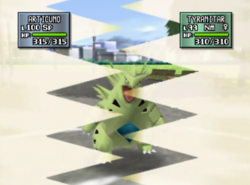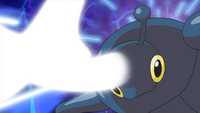The Top 5 Battle System Innovations
|
Pokémon battling is the core to the gameplay experience of the series. Battling drives advancing in the Pokémon League, capturing new monsters and exploring the wide world of the video games. In many ways the core battling experience is the same as it was during Generation I: Turn-based combat based on a 15 (later 17)-way game of elemental Rock-Paper-Scissors. This guiding principle has remained since the very beginning. Spinoff games may tweak the experience or even throw in completely different ones but the main series never wavers.
At the same time though, a player who hasn’t played since Red couldn’t pick up Black and White and expect the same experience he knew 14 years ago. The system has advanced with every new generation by new types, moves, mechanics and items. The smallest additions can rewrite the metagame overnight. Every tweak causes both praise and controversy as old strategies are destroyed.
With that in mind, here is a countdown of the most significant changes to the battle system:
5. Weather
Look at the metagame of Generation V and you’ll see that weather is the dominant force of Generation V. Entire teams are built around strategies of utilizing rain, sun, sandstorms and hail. A subpar Pokémon can be turned into a nightmarish attacker or a defensive powerhouse under the right weather conditions.
What’s interesting about weather is that it took several generations to become the dominant force it is today. Rain, sun and sandstorm were interesting novelties and welcome boosts for corresponding Pokémon when it was first introduced in Generation II. Generation III brought permanent weather-summoning abilities, but these remained confined to the legendary Uber tier, though Sandstorm-producing Sand Stream leaked out via Tyranitar. Abilities also allowed Pokémon to take better advantage of weather, such as speed-doubling Swift Swim or Chlorophyll.
Weather finally came full-circle in Generation V with Drizzle and Drought being granted to Politoed and Ninetales, respectively. Now all three major weather conditions could be utilized in standard play, although hail still had its niche too. Now it’s not uncommon to see weather conditions shift several times throughout the course of a battle.
4. The Physical/Special Split
Up until Generation IV, many Pokémon were simply cursed with having offensive stats that didn’t match up well with their default special or physical oriented elements. Gyarados was stuck with special Water in contrast to its massive Attack stat while Gengar’s Special Attack was let down by Ghost’s status as a physical element. This all changed when Generation IV tweaked the system to have both physical and special moves fall under the same element. Many Pokémon were finally able to take full advantage of their stats. Waterfall became a staple for high attack Water Pokémon. Focus Blast gave special attackers a Fighting move to ward off Dark and Steel types. Tyranitar became the nightmare it was meant to be as its Dark moves Crunch and Pursuit became physical.
Unfortunately, there are still some Pokémon that haven’t been able to benefit from this change. Flareon has yet to get a decent move to utilize its massive Attack stat. Poor flaming poodle.
3. Held Items
This was the first huge advancement in complexity for battling. Pokémon could be given little advancements that could alter the course of battle in ways never quite imagined in Generation I. Attacks could be powered up, status effects could be healed instantly, turns wouldn’t be wasted to restore hit points. Later generations gave held items even more potency. Items were introduced that altered attacks, altering weather and even altering some Pokémon’s types.
Just like weather, Pokémon strategies would be built around items. The Choice Band and Specs helped to beef up attackers while the Choice Scarf gave slower Pokémon a chance to catch up to quicker monsters. Leftovers became the gold standard for Wall and Stall-based strategies. The ice-weakening Yache Berry gives Salamence and Garchomp relief from that dragon-bane Ice Beam. A Pokémon’s usefulness can go in so many directions simply because of item choice.
2. Dark and Steel
Let’s face it: Psychic was a broken type in Generation I. They benefitted from the fact that the Special stat counted for both Special Attack and Special Defense plus the fact that since there were so many Poison Pokémon in Kanto, Psychic was super effective against 1/4th of all Pokémon, and then there was its advantage against Fighting on top of that. Ghost, the type that was supposed to counter it, had no useful moves and the only Ghost Pokémon were also half Poison.
Gold and Silver delivered a one-two punch to Psychic. The introduction of the Dark and Steel types represented the first real balancing of the battle system. Not only did Steel resist Psychic, Dark was outright immune and its attacks were super effective against Psychic. Dark and Steel also gave new life to Bug and Fighting types, which had few advantages against other types in Generation I. Fighting in particular became one of the two most important offensive types in the game: It ties with Ground to deliver super effective moves against five types.
1. Abilities
This is the big one. No other advance in the system has changed the game as much as this gem from Generation III. Abilities completely changed the dynamics of how Pokémon were used in battle and the strategies using them.
The usefulness of an Ability could make a Pokémon with high stats and strong attacks worthless or a subpar Pokémon invaluable. Slaking is rendered useless because of Truant and on the flipside Scizor rose up to become the most widely used Pokémon of Generation IV because of the peerless combination of the Technician ability with the move Bullet Punch.
Hidden Abilities from Black and White gave many more Pokémon a new chance to shine with more possible Abilities. Blaziken found itself banished from standard play simply because it made much better use of its new toy, Speed Boost, than the original users Ninjask and Yanma/Yanmega.
No other innovation to the battle system has been as prominent or game changing. The history of the battle system in Pokémon may as well be separated into two eras: Before Abilities and After Abilities.
Honorable Mentions
The Special Split- One would think this would be right up there next to the Physical/Special Split, but this one wasn’t nearly as game changing. It simply came off as something that was a logical fix to make: Attack and Defense dealt in physical fighting, so why should a single stat cover both how hard a Pokémon’s special moves could hit and how much it could take?
Stealth Rock- This isn’t so much an innovation to the system but it still qualifies as a game changer. Whether you like what it did to the metagame or not, Stealth Rock undeniably set the foundations for the Generation IV metagame. Entire types found themselves at a disadvantage simply because of a rock weakness. Pokémon with a double-weakness to Rock found themselves quickly exiled from common use. This is probably why Stealth Rock was no longer a TM in Black and White, although it’s returned as a Move Tutor in Black 2 and White 2.
Charizard, you are still dearly missed.
Megahorn/Outrage/Shadow Ball- These three moves didn’t so much change the game as they made their respective types legitimate threats. Bug, Dragon and Ghost had zero useful moves in Generation I. Bug and Ghost only had the weak Leech Life and Lick to do regular damage, while Dragon had no moves outside of the set damage of Dragon Rage. These three moves finally gave these types a chance to shine, and later generations would only keep up the generosity.
Agree? Disagree? Let me know on the forum discussion!
GodofPH, AKA Pat Hessman, is a senior studying Film at Montana State University. He wrote a series of articles for Bulbanews prior to the Black and White release entitled "Looking Forward". He is relearning that Torchic is gifted by Professor Birch and not Professor Elm.


